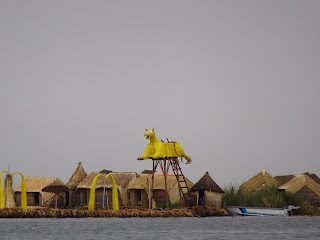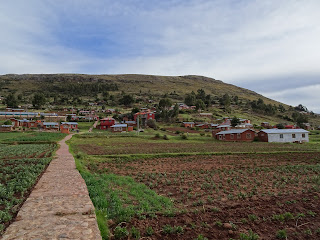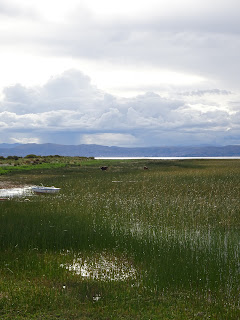Titicaca is the highest navigable lake in the world. It is huge, and used to be much larger till geology chopped it short a long time ago. It is famous to for it's floating villages (built on reed rafts). We had a trip out to visit one of these villages, Taquile Island, and then an overnight home-stay in a rural/farming community.
The day started with a damp rickshaw ride down to the harbour.
About half an hour on the boat took us out to the floating village, made up of lots of smaller 'family' islands. The 'Duck' island we visited had about 5 families living on it and we were shown around by the 'president' of the island, including an explanation of how the islands are created and maintained.
 |
| 'Duck' island |
 |
| Layer upon later of reeds |
 |
| Some of the fish they catch and eat |
 |
| Dried birds and eggs |
Lots of the islands had reed 'statues' or towers, and I asked if they had any particular significance. Turns out their primary purpose is to make the island easy to find among all the other islands!
We explored the island and chatted with the locals, seeing inside their houses and looking at their wares. We also tried on some traditional garments to see what it was like, which the locals seemed to find amusing.
After visiting the floating islands, we motored through the reed beds and mud flats and out onto the lake proper. The reed beds are home to loads of water birds, and also pigs farmed by the villagers.
 |
| Local bringing back some freshly harvested reeds |
Before our lunch of lake fish, we were treated to a local dance, and demonstrations from the ladies of their weaving, and from the men of their knitting. Knitting is a standard past time of the men here, and to prove yourself to a potential bride's family they will want to inspect your knitted hat. There must be basically no give in it at all! This is proving a little problematic for the girls who get boyfriends not from the island as their attempts at hats are fairly rubbish.
After that it was back on the boat and back to a peninsula of the mainland to our overnight home-stay village.
The village has a primary school, but no shops as far as I could tell. There was one rough road about halfway up the hill that leads eventually to Puno. We were encouraged to take gifts of useful things to our host family, like rice, pasta, oil, and jam.
I was shown round the village by the host family's 5 year old daughter, Linda. She didn't speak any english, and my Quechua is non-existant, but we managed and became bestest friends! I introduced her to the 'fart piano' app on my phone, which provided her and her friends good fun for 20 minutes or so. She showed Lee and I how to work the fields, which we did for a while, but it was knackering and I'm not sure we actually improved the soil at all! By the end of the stay she was happily calling me 'gringo loco', which I have been assured was a term of endearment.
I did get a bit more of a chance to do some wildlife spotting while there (Dad will like the photos!), and in the evening the moon was incredibly large and clear. Not sure I've ever seen it so magnificent before.



































Birds: Common Moorhen; Puna Ibis; Puna Teal (blue beak); Titicaca Grebe (which is flightless); Andean Gull; can't identify yellow beaked duck and it may a domestic hybrid of some sort. Keep 'em coming. Love Dad
ReplyDelete